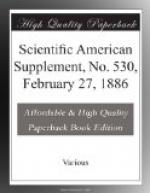* * * * *
A NEW BLEACHING PROCESS.
In the spring of 1883 a Mr. J.B. Thompson, of New Cross, London, patented a new process of bleaching, the main feature of which consisted in the use of carbonic acid gas in a closed vessel to decompose the chloride of lime. The “chemicking” and “souring” operations he performed at one and the same time. The reactions which took place in his bleaching keir were stated by the inventor as follows:
Cl.\
1. Ca ) + CO_{2} = CaCO_{3} + Cl_{2}.
OCl./
2. OH_{2} + Cl_{2} = (ClH)_{2} + O.
3. CaCO_{3} + (ClH)_{2} = CaCl_{2} + CO_{2} + H_{2}O.
That is, in 1 chloride of lime and carbonic acid react upon each other, producing chalk and nascent chlorine; in 2 the nascent chlorine reacts upon the water of the solution and decomposes it, producing hydrochloric acid and nascent oxygen, which bleaches; in 3 the hydrochloric acid just formed reacts upon chalk formed in 1, and produces calcium chloride and one equivalent of water, and at the same time frees the carbonic acid to be used again in the process of decomposing the chloride of lime.
When the process was first brought to the notice of the Lancashire bleachers, it met with an amount of opposition. Some bleaching chemists declared the process was not patentable, as fully half a century ago carbonic acid was known to decompose chloride of lime. The patentee’s answer was emphatic, that carbonic acid gas had never been applied in bleaching before. After some delay one of the largest English cotton bleachers, Messrs. Ainsworth, Son & Co., Halliwell, Bolton, threw open their works for a fair test of the Thompson process on a commercial scale.
The result of trial was so satisfactory that a company was formed to work the patent. Soon after this the well-known authorities on the oxidation of cellulose, Messrs. Cross & Bevan and Mr. Mather, the principal partner in the engineering firm of Mather & Platt, of Salford, Lancashire, joined the company. For the last twelve months these gentlemen have devoted considerable attention to improving the original contrivance of Thompson, and a few weeks since they handed over to Messrs. Ainsworth the machinery and instructions for what they considered the most complete and best process of bleaching that has ever been introduced.
Recently a “demonstration” of the “Mather-Thompson” process of bleaching took place at Halliwell, and to which were invited numerous chemists and practical bleachers. Having been favored with an invitation, I propose to lay before your readers a concise report of the proceedings.




